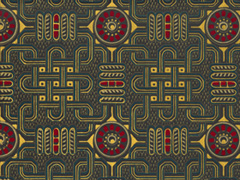| |
The Henry Ford’s Wallpaper Collection
The Henry Ford’s wallpaper collection serves as a guide to the changing tastes of Americans from the early 1700s to the mid-1900s. Much of it encompasses the heyday of American wallpaper production--the era from the 1860s into the 1910s. Every major artistic style is represented, including simplified, mass-market variations of elite styles of the day.
 |
 |
(left) This stylized Gothic Revival design in shades of maroon was an affordable paper made for the mass market. Victorian wallpaper designers drew upon “picturesque” gothic design motifs like the ornamental open work found in stained glass windows of medieval cathedrals.
(right) This blue floral paper is extremely naturalistic, by contrast. Yet, both date to the 1870s, demonstrating the wide range of popular styles of the day. ID.THF67934 and THF67931
|
 |
 |
(left) High-style looks are seen in this paper designed by the celebrated English designer Christopher Dresser. Made for the American market, this wallpaper includes abstracted designs influenced by a craze for all things Japanese during the late 1870s and 1880s. (right) Another English-influenced design may be seen in this stylized botanical paper dating to the 1880s. It represents the Arts and Crafts Movement, composed of designers who reacted against the “excesses” of “overwrought” Victorian design by embracing a more pure and simplified look. Viewed as a pair, these papers are examples of high-style “artistic taste” of the late 1870s and 1880s. ID.THF67933 and THF67929
|
 |
The collection also includes a significant number of classically-inspired borders and other wallpaper details. Dating from about 1890 to 1910, many of these depict architectural elements from ancient Greece and Rome. This border represents the egg and dart pattern, one of the most common designs in Greek and Roman architecture. The boldness and large size of patterns like this one are references to the glories of the ancient empires, which Americans sought to emulate. ID.THF67932 |
By the early 20th century, elaborate wallpaper decoration began to fall out of favor. This long-lasting trend accelerated after World War II. In recent decades, wallpaper made something of a comeback--but wallpaper’s use was minor compared with its popularity in Victorian America. The late 19th century stands as a high water mark in the history of American wallpaper.
| |
-- Charles Sable, Curator of Decorative Arts |
Wallpaper at the Sarah Jordan Boarding House

|
Sarah Jordan, a widow of limited means, supported herself and her daughter, Ida, by running this boarding house for Thomas Edison’s assistants at his Menlo Park, New Jersey, Laboratory during the late 1870s and early 1880s. ID.THF67943 |
The Victorian affection for wallpaper is visible in the Sarah Jordan Boarding House, reopening this month in Greenfield Village. The love of wallpaper is evident even in this lower middle-class home, as every important room is lavishly decorated--at least by early 21st century standards.
The wallpapers in the home are reproductions of those popular during the early 1870s, when the house was built. The two papers shown below have been reproduced from Victorian wallpapers in The Henry Ford’s Collection.
|
|
|

